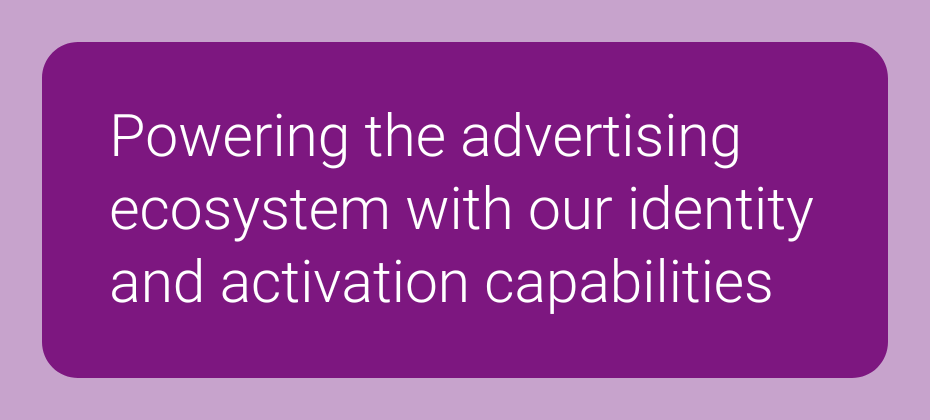
Not all customers are the same, so why waste your budget marketing to them like they are? McKinsey research shows that 71% of consumers want personalized shopping experiences, and 76% get frustrated when they don’t have them. That’s where demographic segmentation comes in.
But what is demographic segmentation, exactly? We define it as a process that helps you categorize your audience into meaningful demographic groups so you can reach the right people with impactful custom messages.
Businesses across industries are partnering with Experian to power smarter decisions and better results through solutions like demographic segmentation — but what does this look like in action? This article breaks down five real-world demographic segmentation examples, showing how businesses have worked with us to drive measurable success so you can see exactly how it can work for you.
What is demographic segmentation?
Demographic segmentation involves dividing your audience into smaller, more specific groups based on shared demographics like income, education, gender, job, family status, and more to gain a more granular understanding of your brand’s target segments. The better you know your audience, the better you speak to their unique needs — and the more effective your campaigns will be, as you’ll be able to target each segment with highly personalized content that resonates.
For instance, a company might market a new tech gadget to young adults in one way while promoting the same product to families with young children in a completely different way, ensuring the message speaks to each group’s lifestyle and priorities.
Demographic segmentation attributes
Some of the most common attributes used in demographic segmentation include:
Benefits of using demographic segmentation
Demographic segmentation offers several valuable benefits for marketers. Here’s why it’s one of the most commonly used and effective ways to target audiences:
- Improved targeting and personalization: Demographic segmentation powers highly customized campaigns so you can cater to different income levels, family structures, job types, and so forth. B2C brands can provide offers based on factors like age, income, and gender, while B2B brands can target by occupation to reach decision-makers.
- Better product and service development: Understanding which demographics use your product or service is a great way to inform future improvements.
- Higher engagement: With highly customized content, you can speak directly to specific demographic groups and increase engagement.
- Cost efficiency: As you target the most relevant segments, you optimize your spending around the most likely buyers and will see better returns.
- Increased conversion and retention: Relevant, targeted messaging leads to higher conversion rates, and when people feel understood, they’ll want to keep coming back.
- Clearer customer insights: Demographic data provides precise, actionable insights for refining your marketing strategy.
- Simplicity and effectiveness: Demographic insights are immediately actionable and easy to implement, which gives you a great starting point for focused campaigns.
When to use other segmentation types
While demographic segmentation provides valuable consumer insights, there are times when other approaches may offer a more effective strategy:
- Your business provides location-dependent services. If you strictly serve a local area, geographic segmentation would be more effective in targeting customers based on location.
- You have access to detailed behavioral data. If you collect data on customer behavior (like browsing history or purchase patterns), behavioral segmentation would allow for more personalized targeting than demographics.
- You’re selling high-end luxury products. While income is a useful demographic variable, factors like values, aspirations, and lifestyle better capture the desires of luxury consumers.
- Your target audience shares similar behaviors, regardless of demographic factors. Behavioral segmentation might offer more insight if your customers engage with your product or service based on shared behaviors rather than demographic traits.
- Your product or service targets specific needs or pain points. Segmenting by need or issue rather than traditional demographic variables would likely yield better results if you’re offering a solution to a particular problem (like a health-related product).
How our customers are using demographic segmentation to produce tangible results
Demographic segmentation is about knowing your audience and using data to create marketing strategies that drive measurable outcomes. Let’s look at some real-world use cases from brands like yours that have been successful in this effort, working with Experian to translate demographic insights into significant business growth.
Use case #1: Identifying customer spending potential to boost growth for a retail chain
These demographic segments provided the marketing strategy the retail chain used to target $1.1 billion in unrealized spend. This revealed how much additional revenue could be captured by targeting the right customers with tailored marketing and offers through demographic segmentation.
Use case #2: Helping a financial institution identify regional DE&I opportunities
Use case #3: Segmenting a health supplement ambassador program for enhanced engagement
Use case #4: Comparing customer bases: Insights for a retailer across two cities
These adjustments led to improved engagement and higher sales in both cities.
Use case #5: Optimizing direct mail to help a nationwide retailer maximize impact on a limited budget
Explore demographic segmentation with Experian
Now that we’ve defined demographic segmentation and provided real-world examples, it’s time to explore how Experian data can help you better understand and connect with your audience. Experian’s Marketing Attributes provide rich, privacy-conscious insights into consumer demographics, lifestyles, and behaviors. These insights empower marketers to personalize experiences, refine targeting strategies, and make more informed decisions. With a deeper understanding of who your customers are, you can create more meaningful, impactful campaigns that drive stronger engagement and results.
Connect with us today to see how our data and expertise can improve your targeting, personalization, and campaign performance.
Connect with us
Latest posts

At Experian, we understand the importance of audience targeting when it comes to crafting a successful marketing campaign. We are excited to share a curated list of audience recommendations to support your campaign planning so you can confidently connect with your audience. What separates Experian’s syndicated audiences Experian’s 2,400+ syndicated audiences are available directly on over 30 leading television, social, programmatic advertising platforms, and directly within Audigent for activation within private marketplaces (PMPs). Reach consumers based on who they are, where they live, and their household makeup. Experian ranked #1 in accuracy by Truthset for key demographic attributes. Access to unique audiences through Experian’s Partner Audiences available on Experian’s data marketplace, within Audigent for activation in PMPs and directly on platforms like DirectTV, Dish, Magnite, OpenAP, and The Trade Desk. New and improved audience segments we recommend for Q1 campaigns Q1 is the ultimate season for TV, with the NFL playoffs, Super Bowl, College Football playoffs, award shows and so much more capturing viewers’ attention. That’s why we're excited to introduce 14 new and 8 updated television audiences. Recently released on major platforms, these new television audiences offer unique opportunities to align your campaign planning with the latest viewer behavior trends. Cable Satellite or Streaming Network Subscribers Satellite Service Subscribers Mutli Brand TV Owners Seasonal audiences for Q1 New Year’s audiences As the new year approaches, it’s the ideal moment to connect with consumers inspired by their New Year’s resolutions. In 2024, one-third of U.S. adults set goals for the year, focusing on key areas like healthier living, getting organized, exploring new experiences, and improving financial wellness. Experian’s New Year’s resolution audiences provide valuable insights into these aspirations, allowing you to tailor your messaging and engage with consumers determined to make positive changes in 2025. From promoting healthy lifestyles and travel to supporting organization and financial goals, Experian’s data-driven solutions help you capture these motivated audiences with precisely targeted messaging. Learn more here Football audiences Football season presents an unmatched opportunity for brands to connect with one of the most engaged audiences in the U.S. As in-game ad costs continue to rise and slots fill up quickly, brands are seeking innovative ways to reach passionate football viewers beyond the game. Experian’s specialized football audience segments allow advertisers to engage with fans across categories like NFL stadium visitors, college football enthusiasts, beer drinkers, and dedicated TV viewers, ensuring your brand connects meaningfully with consumers throughout the season. Read more here Financial audiences With tax season just around the corner, brands have the opportunity to connect with financially engaged audiences in the U.S. Whether your goal is to reach self-starters managing their own returns or high-net-worth individuals seeking advanced tax solutions, Experian can ensure your brand connects meaningfully with the right financial audience at the right time. Experian’s specialized financial audience segments empower brands to engage with key groups, such as: Tax Return – Self prepare user Tax Return – Online tax software user Tax Return – Professional Service Preparer user Savvy Sounding-Board Seeking Investor Price Sensitive, Self-Directed Investor Top recommendations for Q1 Based on the top Experian audiences activated in Q1 of 2024, our top 10 list is designed to assist agencies and media buyers plan data-driven advertising campaigns. Occupation 1) Small Business Owners: This segment contains consumers who are likely to be small business owners. 2) Military – Inactive: This segment contains consumers who are likely to be inactive in the military. 3) Legal/Education and Health Practitioners: This segment contains consumers who are likely to have an occupation in Legal/Education and Health Practitioner. 4) Technical: Computers/Math and Architect/Engineering: This segment contains consumers who are likely to have an occupation in Computers/Math and Architect/Engineering. Consumer Lifestyles 5) Vacation/Leisure Travelers: Weekend Getaways: This segment contains consumers who are likely high spenders or frequent purchasers of weekend getaway travel. 6) Women's Sleepwear and Lingerie: High Spenders: This segment contains consumers who are likely high spenders at women's sleepwear and lingerie stores (e.g., Soma, Victoria's Secret). 7) Smart Investors: This segment contains consumers who are likely actively seeking out as much information about an investment as possible before committing, shopping around for the best investment deal, and aversion to financial debt. 8) Computers/Software Frequent Spenders: This segment contains consumers who are likely frequent spenders of computer software. Life Events 9) New Movers: High Spenders: This segment contains consumers who are likely new mover high spenders. 10) New Parents: Child Aged 0-36 Months: This segment contains consumers who are likely to be new parents for children aged 0-36 months. You can find the complete audience segment name in the appendix. Activate the right audiences with Experian For a full list of Experian’s syndicated audiences and activation destinations, download our syndicated audiences guide. Need a custom audience? Reach out to our audience team and we can help you build and activate an Experian audience on the platform of your choice. Connect with our audience team Contact us Appendix Here are the complete audience segment names (taxonomy paths) for all audience segments discussed in this blog post. TV Audiences Television (TV) > Household/Family Viewing > Cable Satellite or Streaming Network Subscribers Retail Shoppers: Purchase Based > Seasonal > Discount Holiday Shoppers Television (TV) > Brand Owners > Multi Brand TV Owners Financial Audiences Lifestyle and Interests (Affinity) > Financial Behavior > Tax Return – Self prepare user Lifestyle and Interests (Affinity) > Financial Behavior > Online Tax Software user Lifestyle and Interests (Affinity) > Financial Behavior > Tax Return –Professional Service Prepare user Financial Personalities > Investments Financial Personality > Savvy Sounding-Board Seeking Investor, Average Investable Assets Financial Personalities > Investments Financial Personality > Price Sensitive, Self-Directed Investor, Very High Investable Assets Occupation Consumer Behaviors > Occupation: Small Business Owners Lifestyle and Interests (Affinity) > Occupation > Military – Inactive Demographics > Occupation > Professional: Legal/Education and Health Practitioners Demographics > Occupation > Technical: Computers/Math and Architect/Engineering Consumer Lifestyles Retail Shoppers: Purchase Based > Travel > Vacation/Leisure Travelers: Weekend Getaways Retail Shoppers: Purchase Based > Apparel > Women's Apparel (Clothing): Women's Sleepwear and Lingerie: High Spenders Financial Behavior > Smart Investors Retail Shoppers: Purchase Based > Technology/Telecom > Computers/Software Frequent Spenders Life Events Retail Shoppers: Purchase Based > Shopping Behavior > New Movers: High Spenders Life Events > New Parents > Child Age 0-36 Months Latest posts

The advertising ecosystem has seen significant transformation over the past few years, with increased privacy regulation, changes in available signals, and the rise of channels like connected TV and retail media. These changes are impacting the way that consumers interact with brands and how brands understand and continue to deliver relevant messages to consumers with precision. Experian has been helping marketers navigate these changes, and as a result, our marketing data and identity solutions underpin much of today’s advertising industry. We’re committed to empowering marketers and agencies to understand and reach their target audiences, across all channels. Today, we are excited to announce our acquisition of Audigent—a leading data and activation platform in the advertising industry. With Audigent’s combination of first-party publisher data, inventory and deep supply-side distribution relationships, publishers, big and small, can empower marketers to better understand their customers, expand the reach of their target audiences and activate those audiences across the most impactful inventory. I am excited to bring together Audigent’s supply-side network as a natural extension to our existing demand-side capabilities. Audigent’s ability to combine inventory with targeted audiences using first-party, third-party and contextual signals provides the best of all worlds, allowing marketers to deliver campaigns centered on consumer choices, preferences, and behaviors. The addition of Audigent further strengthens our strategy to be the premier independent provider of marketing data and identity, ultimately creating more relevant experiences for consumers. To learn more about Experian and Audigent, visit https://www.experian.com/marketing/ and https://audigent.com/. Contact us

Retail media has been on everyone’s radar for a while. Commerce media has also established itself as a significant player in the AdTech industry over the past few years. While retail media focuses on engaging customers within a retailer’s ecosystem, commerce media goes beyond these boundaries to capture the entire shopping journey, spanning multiple touchpoints, channels, and platforms.But what is commerce media, and why should we care? Commerce media is here to stay Estimated to hit $33.86 billion this year and more than double by 2028, the hunt is on to capture as much of retail media’s projected ad spend as possible. However, given the numerous verticals expanding their retail media strategy to include any touchpoint within the commerce channel, it might be time to lower the retail media flag and hoist the LUMA dubbed "commerce media flag." So why are Travel, Financial Services, and other verticals focusing on the commerce media ship? Authenticated and digital users (usually app-driven) Consented data that provides unique insight into the household’s or consumer’s intent/purchase behavior Emerging focus on advertising as an important revenue stream for the future With all this “data” at their disposal — why is it not smooth sailing for commerce media to build an ad-supported business? What’s missing for them to acquire the lucrative billions efficiently and effectively? Why retail media networks are important Retail media networks (RMNs) are now a major tool for brands to connect with shoppers. These networks gather valuable data from customers who browse and shop on e-commerce sites and apps. What makes RMNs so powerful is that they allow brands to advertise directly to people who are already interested in buying, leading to more successful sales. For marketers, RMNs offer a clear way to reach potential customers and ensure their advertising dollars are well spent. But as competition grows and consumer habits change, these networks must keep improving. To stay ahead, brands will have to find new ways to use RMNs effectively, linking them with other parts of the commerce media world to unlock even greater results. Differences between building a loyalty program and developing ad products Loyalty programs are the backbone of commerce media networks; however, creating a loyalty program is much different than building an advertising product. It requires commerce companies to bring on additional people, technology, and partners to execute flawlessly. There are four areas to consider: 1. Organizing your data at scale To successfully build an ad-supported business at scale, data must be organized to initiate action (targeting and/or measurement). However, this requires changes in company culture. Both the business and technology infrastructure must be updated. Additionally, commerce media companies must update their mindset around creating and selling products. 2. People We have seen this story before, with large opportunities comes the requirement for new talent. Where are we seeing commerce media companies recruit from? AdTech and MarTech. Whether it’s engineers or data scientists, business development and partnership leads, or even your direct sales team, the poaching has begun. To build a successful business around advertising, experts are needed who can navigate the waters. 3. Partner vs. build The Requests for Information (RFIs) and Requests for Proposals (RFPs) for any combination of agency, demand-side platform, supply-side platform, customer data platform, identity graph, clean room, and beyond are piling up. One trend is clear: commerce media companies are looking for collaborative partners to provide a true strategic partnership to take on the complexities of the transition away from retail media. 4. Identity will remain the keystone to success All commerce media companies have some identity data that reveals a slice of their customers’ viewpoint. Yet, unlocking the broad view of these audiences is crucial to success. These companies need to use the “full pie” to see well-rounded profiles, gain the reach required to access them across many channels, and turn opportunities into revenue. Advertisers can finally close the loop with commerce media networks Commerce media companies with real-time transaction data enable advertisers to see true ROI on their ad spend when products move off the shelves. Measuring real product lift/sale touch points across multiple channels will put performance and measurement front and center. Programmatic was the promise of performance advertising. Well, commerce media may finally fulfill that vow, creating enough value for companies to make it a real competitor to social channels. While retail media will always exist, the transition to commerce media has become increasingly popular and is here to stay. The journey might not be a straight shot to perfect results, but the data, partnerships, and resources are out there and ready to hop aboard to help guide commerce media companies to success. The future of commerce media Commerce media shows no signs of slowing down. More industries are seeing the benefit of making every customer touchpoint an opportunity to drive sales. Whether through social media shopping or in-app purchases, commerce media pushes businesses to create smoother, more connected shopping experiences for consumers. In the future, brands won’t just compete on prices or products — they’ll stand out by offering simple, seamless shopping experiences across all devices. With better data and tools to track consumer behavior, brands will be able to personalize their ads and measure their success in real time. Commerce media allows brands to see a direct link between their ads and sales. Those who can adapt and keep up with these changes will come out on top. Create a connected customer view with Experian At Experian, we empower RMNs to unlock the full potential of their first-party data through comprehensive identity and audience solutions. Our data-driven capabilities enable RMNs to build a deeper understanding of their customers, optimize audience targeting across channels, and create enriched, actionable segments that drive measurable outcomes. By seamlessly connecting our offline and digital data, we help RMNs organize identities into households, device IDs, and more. Each household is enriched with valuable marketing insights, allowing you to gain better customer understanding, create targeted advertising, and reach the right customers across different devices. Additionally, you’ll be able to measure the effectiveness of your advertising efforts. With our support, RMNs can maximize revenue opportunities, extend reach, and confidently demonstrate the value of the network to advertisers. Contact us today to find out how Experian can help you succeed in commerce media. Contact us Latest posts

